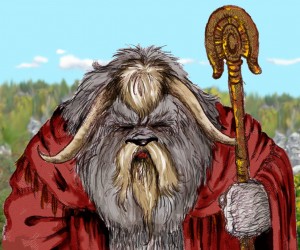Tags

And so with this post I also begin to introduce the denizens of Kryslan. The image to the right is of one of the Tylnor, in this case an elderly hermit who lives in the mountains near the Temple of Mognokum. The Temple itself is located in the city of Kavok, but a number of hermits live in the mountains outside the city. The subject of the image has his eyes tightly closed and is engaged in one of the visualization meditations on the Divine Tronulumdad, the three mythical figures who took over stewardship of the world from Mognokum and Galyluma.
The Tylnor come into the origin of the name of the world: Kryslan. The word Kryslan comes originally from a Drushek word meaning “a vessel or container” in that the world holds all things within it. (More on the Drushek later…) The Tylnor would dispute this, since ties between the Drushek and Tylnor were severed long ago. According to Tylnor scholars, kryslan derived from the root krysl (with a syllabic l ending, rhyming with the American English word gristle). Krysl is a verbal root in the Tylnor language meaning “challenging, testing” and ultimately comes from the word relating to ancient competitions when Tylnor would butt heads as a test of strength. The ending -an is a nominalizer, making the verbal root into a substantive: Kryslan (the syllabic l combines with the suffix: Krys – lan). This gives the meaning “That which challenges” or “That which tests”. Tylnor see the world as one challenge after another, testing their mettle and resolve, to prove themselves worthy of taking on whatever the world throws at them. Meeting these challenges gives them an honored place in the army of Morganumon after they die and the opportunity to confront the ultimate challenge: fighting back the forces of Ogdolgan and preserving the world (thus providing further worldly challenges to future Tylnor).
